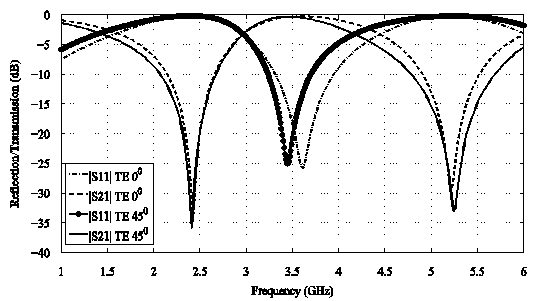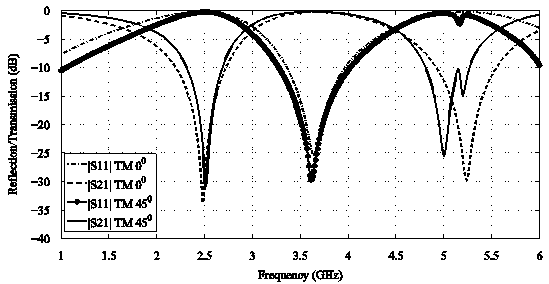-
Paper Information
- Previous Paper
- Paper Submission
-
Journal Information
- About This Journal
- Editorial Board
- Current Issue
- Archive
- Author Guidelines
- Contact Us
International Journal of Electromagnetics and Applications
p-ISSN: 2168-5037 e-ISSN: 2168-5045
2012; 2(6): 182-185
doi: 10.5923/j.ijea.20120206.08
A Novel Dual-Band Frequency Selective Surface Absorber
Mudassar Abdin , Umair Rafique , Fahad Malik , Shahzaib Qasim , M. Arif Khan , M. Mansoor Ahmed
Department of Electronic Engineering, Mohammad Ali Jinnah University, Islamabad, 44000, Pakistan
Correspondence to: Umair Rafique , Department of Electronic Engineering, Mohammad Ali Jinnah University, Islamabad, 44000, Pakistan.
| Email: |  |
Copyright © 2012 Scientific & Academic Publishing. All Rights Reserved.
In this paper, a dual-band Frequency Selective Surface (FSS) absorber is presented for Wireless Local Area Network (WLAN) security. The FSS absorber is designed for two frequencies of interest, i.e., 2.45 GHz (lower band) and 5.25 GHz (upper band), respectively. FSS design consists of two layers; first layer consists of conducting square-loop elements while second layer consists of resistive square-loop elements, placed in-front of a conducting FSS layer. The proposed FSS design provides good frequency stability for oblique incidences for perpendicular (TE) and parallel (TM) polarizations. It provides better absorption rate for 2.45 GHz and 5.25 GHz frequency bands and allow the transmission of other microwave frequencies. Also, the proposed FSS design reduces multipath fading of additional WLAN signals which occurred due to the placement of conducting FSS layer. Presented results demonstrate that the proposed FSS design has a stable frequency response for the desired frequency bands for TE and TM polarizations with good absorption rate when the incident wave angle varied from 00 to 450.
Keywords: Dual-Band, Frequency Selective Surface (FSS), Wireless Local Area Network (WLAN), Oblique Incidences, Perpendicular Polarization, Parallel Polarization
Cite this paper: Mudassar Abdin , Umair Rafique , Fahad Malik , Shahzaib Qasim , M. Arif Khan , M. Mansoor Ahmed , "A Novel Dual-Band Frequency Selective Surface Absorber", International Journal of Electromagnetics and Applications, Vol. 2 No. 6, 2012, pp. 182-185. doi: 10.5923/j.ijea.20120206.08.
Article Outline
1. Introduction
- Now-a-days, the use of Frequency Selective Surfaces (FSSs) is becoming popular as a free-space filter design. It was first demonstrated by Ben A. Munk and used the presented technology for airborne applications[1]. Many researchers proposed FSS designs for other microwave related problems, in which radome design for radar applications gets popularity[2]. Other applicationsassociated with FSSs are radar and analog absorbers[3-4], High Impedance Surfaces (HISs) for the enhancement of bandwidth and gain of an antenna[5], band-pass filter design for the transmission of radio frequencies through energy saving windows[6], resonator design or Electromagnetic Band-Gap (EBG) structure for the coupling reduction between microstrip patch antennas[7], quarter-wave polarizer to change the polarization of incident wave[8], etc.In this work, our main focus is to design Frequency Selective Surface (FSS) absorber to provide security for WLAN signals. As WLANs are based on radio frequency (RF), the information which transmitted from one point to another can be hacked or tapped by intruders. A band-stop filter can be used to provide security, but it can attenuate other useful microwave signals. So, there is a need of such type of filter which only provides attenuation for the desired frequencies and allow other communication bands to pass through it. This can be done by the designing of FSS absorber. The design and configuration of FSS absorber was first presented by Salisbury and Jaumann[9-12]. The presented designs are much easier to model, but the problem associated with the designs is the unwanted attenuation to other communication bands. To overcome this problem, many researchers proposed different techniques anddesigned FSS absorbers for different microwave applications. In[13], authors presented FSS absorber for mm-wave applications. They used full ground plane instead of conducting FSS to get absorption for wide range of frequencies. But, the presented results showed that it can attenuate communication bands other than the band of interest, because the ground plane is directly printed on the bottom of dielectric. Also, the stability characteristics of the presented design were not checked at oblique incidences which are the major problem in the designing of FSS absorber. In[14], authors presented same kind of FSS absorber as that of[13] for single band operation. They used lossy dielectric slab and due to the use of this technique they got good frequency stability at different incident angles. Also, the transmission of other communication bands is not disturbed.As discussed above, stability is one of the major problems in designing of FSS absorber. In the last decade, researchers proposed different techniques to get rid of this problem. In[15], authors presented a simple fractal FSS structure to get frequency stability. But, they have designed different structures for different incident angles. In[16-17], authors presented fractal shaped band-stop and band-pass FSS to get stability at maximum angle of incidence. They have presented good frequency stability, but the presented designs are difficult to model and fabricate. In[18], a simple FSS structure based on cross-dipole elements was presented. Authors used Genetic Algorithm (GA) optimization to get a novel design. Analytically this is a good approach, but its practical implementation not yet available. Also, the above discussed designs are only associated with band-stop and band-pass characteristics.The FSS absorber for WLAN security was first time presented in[19]. The overall design configuration is based on the principle of Salisbury and Jaumann absorber[9-12]. After that, in[20], the oblique incidence performance of FSS absorber design was presented which was the modification in[19]. Maximum frequency stability and absorption rate was demonstrated by sandwiching the conducting FSS element between two dielectrics. But the presented design lost its functionality at TM 450 angle of incidence because the conducting FSS element was not able to function properly due to some air gap between the layers. Also, it is hard to fabricate such kind of configuration. In[21], authors presented simple and compact FSS absorber design for WLAN security. But, the problem remains the same that for TM 450 the absorption is not band limited.In this paper, a novel FSS absorber design is presented for 2.45 GHz and 5.25 GHz WLAN security. The proposed design has the ability to absorb WLAN signals at better rate. Also, the stable frequency response is achieved up to 450 oblique angle of incidence for both TE and TM polarizations. The presented design is fully obeying the principle of Salisbury and Jaumann absorber design and also the distance between the conducting and resistive sheets is managed according to the criteria[9-12].The remainder of the paper is as follows. Section 2 describes the design and configuration of dual-band FSS absorber. Section 3 describes the results and discussion on the results. Finally, we conclude the paper in Section 4.
2. Design and Configuration of Dual-Band FSS Absorber
- This section describes the design and configuration of dual-band FSS absorber. The overall design parameters and configuration is shown in Fig. 1. First, a conducting sheet which consists of two square-loop elements is designed to demonstrate the reflection properties of dual-band FSS design. The distance between the two conducting elements is equal to λo/2. The outer square-loop element is tuned to 2.45 GHz and inner square-loop element is tuned to 5.25 GHz, respectively. The dimensions of both the elements are shown in Fig. 1. The dielectric used for the design purpose is FR-4 having dielectric constant εr = 4.4 and thickness 1.6 mm. The function of conducting FSS layer is to provide reflection for WLAN signals while passing other useful microwave signals. The square-loop elements are designed according to the formula which is given below
 | (1) |
 | (2) |
 | Figure 1. Design and configuration of dual-band Frequency Selective Surface (FSS) absorber |
3. Simulation Results and Discussions
- To demonstrate the above described design, a simulation setup is set by using Ansoft HFSS. The simulations are done by applying real time boundary conditions. The results for perpendicular (TE) and parallel (TM) polarizations for 00 and 450 oblique incidences are presented here.First of all, conducting FSS layer which consists of two square-loop elements are simulated to demonstrate the reflection properties of FSS design. Fig. 2 shows the reflection and transmission coefficients of a stable conducting FSS layer at TE polarization. For 00 and 450 oblique angle of incidence, the resonant frequencies are 2.42 GHz, 5.22 GHz, 2.41 GHz and 5.25 GHz, respectively. The transmission coefficients corresponding to the resonant frequencies are -34.1 dB, -29.5 dB, -35.7 dB and -33.08 dB, respectively. The reflection coefficients at the resonant frequencies are almost 0 dB which means that maximum reflection occurred in the bands of interest. Fig. 3 shows the reflection and transmission coefficient results for TM polarization. For 00 and 450 oblique angle of incidence, the resonant frequencies are 2.48 GHz, 5.24 GHz, 2.51 GHz and 5 GHz, respectively. The transmission coefficients corresponding to the resonant frequencies are -33.7 dB, -29.8 dB, -30.8 dB and -25.5 dB, respectively. In this case, the reflection coefficient at the resonant frequencies is almost 0 dB.
 | Figure 2. Reflection and transmission coefficients of conducting FSS layer for TE polarization |
 | Figure 3. Reflection and transmission coefficients of conducting FSS layer for TM polarization |
 | Figure 4. Absorption characteristics of dual-layer FSS absorber for TE polarization |
 | Figure 5. Absorption characteristics of dual-layer FSS absorber for TM polarization |
4. Conclusions
- A dual-band Frequency Selective Surface (FSS) absorber is presented for WLAN security. The FSS absorber design is based on two FSS layers which consist of two square-loop elements tuned to 2.45 GHz and 5.25 GHz, respectively. The proposed FSS design provides maximum stability for the desired WLAN frequency bands for both perpendicular (TE) and parallel (TM) polarizations when the incident wave angle changed from 00 to 450. The performance of design is demonstrated through real time simulation and it is noted, that the FSS design will be able to absorb desired frequency bands for the wide range of incidence angles. Research is in progress to achieve maximum absorption rate for WLAN upper band (5.25 GHz) with the reduction in distance between two layers.
 Abstract
Abstract Reference
Reference Full-Text PDF
Full-Text PDF Full-Text HTML
Full-Text HTML